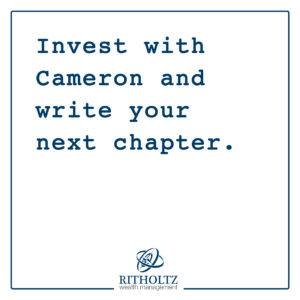Do you feel like the market is going to tip over any day now? The recent volatility is just the first telltale sign, right?
But, the grass is always greener on the other side. Isn’t it?
It’s so easy to look at what we don’t have, or what we wish we had, and fantasize about how much better off life would be if we just had that one thing.
One saying throughout our firm goes, “we invest in the markets as they are, not as we wish them to be.” When trying to do the opposite, you either end up sitting on the sidelines way longer than you originally intended, or you make emotionally charged decisions that could be detrimental to the whole reason you’re even investing.
In the event of a correction or even a recession, this is a long-term investor’s dream. If everything in the grocery store was on sale for 30% off you wouldn’t turn around and say “I don’t trust this, I’m going to come back when the prices are much higher.” People would think you’re insane. So why is it ok when it comes to our money? If you truly want to put your dollars to work, employ them when unemployment is high.
Your Own Worst Enemy
We all have biases and psychological tendencies that affect how we view risk, our ability to handle it, and ultimately how we invest. But with anything, in order to change a habit, we must become aware that it is indeed a habit.
The four main biases I want to bring to your attention today are known as regret aversion, outcome and conservatism bias, and self-control bias. If you resonate with one of these common biases, it may be time to hit the pause button and decide if a new strategy needs to be implemented.
1. Regret aversion
The fear that whatever decision or action you take could be wrong, so you do nothing. It’s been known that investors with a strong regret aversion – with no awareness or confrontation from an advisor- lead to long-term underperformance and could fail to meet their goals. Now, we don’t believe that your goals require you to beat the market year after year to be successful, but let’s not be silly here. Underperforming for a long time can’t be good for anyone.
2. Outcome Bias
First, having an outcome bias means you show the tendency to take a course of action based on the outcomes of events that happened in the past. Meaning, you say, “look what happened in March, then September. Won’t be me this time.”
3. Conservatism bias
On the same line of thinking is the conservatism bias. This mental block is when you initially form a rational view but fail to change that view as new information becomes available.
Look, no one can predict the future, no matter how deja vu, how much it reminds you of a time, whatever. The best we can do is plan accordingly and adjust to new information.
4. Self-control bias
As humans we all have fears. Wants. Wishes. But those same emotions seriously impact what we do in times of stress. Behavioral economists believe that individuals, who lack self-discipline, favor immediate gratification over their own long-term goals. They seek comfort over risk. Admittedly, I do too at times.
Most of these biases can all be overcome by simply turning investing on autopilot through dollar-cost averaging. I know no one likes simple answers. But seriously, systemically investing takes the guessing game out of not knowing when is the right or wrong time to invest.
Overthinking Sh*t
Just because the market moves in an adverse direction for you doesn’t always mean it’s the end of a great run.
Although I was no sophisticated investor back then, I feel like ever since 2008 people constantly want to be in front of any major pullback. This should explain why some people have been just sitting on the sidelines even since before March of last year. Even though the S&P alone recovered at least 76% YTD from March to March.
Have you ever heard the story of the dog and his new bone?
On a dry fall night, a stray dog finds a rib bone with just enough life still on it to be excited.
Elated with joy, he runs as fast as he can to find the perfect place to chew on his new bone. Through the streets and cutting corners, nothing can stop him now. Scurrying across a footbridge, he catches a glimpse of his own reflection in the water below.
Believing he saw another dog with a much better bone than his own, he jumps into the water, drops the bone, and starts to chase him. Only to then realize, he’s all alone in this shallow water. He walks away, still thinking about the amazing bone he could have still had.
If you’re nervous to get into the market right now because you feel like prices are way too high, that is either fear or greed talking to you right now. I’m telling you, that shouldn’t stop you from investing now, tomorrow, or in the middle of March 2020. The moral of that story is that we often don’t see that what we have is good, or at least good enough until it’s gone. Then we realize we can’t get time back.
When it comes to the big dips – corrections, recessions, and depressions – there are various strategies to take advantage of each of these “features, not bugs” of the market, as my colleague Blair duQuesnay would say.
Now, if hesitation still persists, you could be taking on more than you realized you could handle. The problem isn’t the market conditions, it’s your allocation. But that’s for another post.

